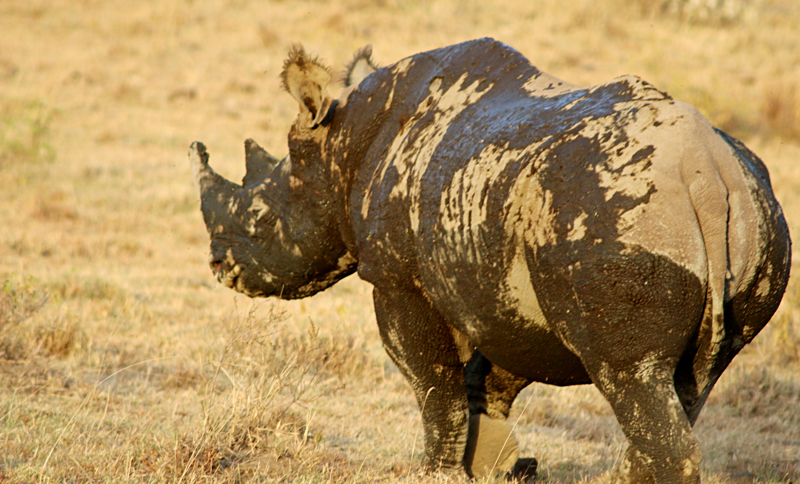Note: This article was originally published on Saturday, June 25, 2016 at 12:52 in the morning and has been updated.
The elusive black rhinoceros is a critically endangered species native to Kenya and other countries in eastern and southern Africa — so much so that the Western Black Rhinoceros was officially declared extinct in 2011 by the International Union for Conservation of Nature and Natural Resources.
Despite that statistic, that same organization reported fewer than two years later that poaching and illegal trading pertaining to the rhinoceros had reached their highest levels in 20 years. As a result, the population of black rhinoceros individuals may be many as 6,421 in 2025 — up from 5,455 in 2015 and still critically endangered; but not nearly as bad as in 1993, when there were only approximately 2,300 individuals, according to Save The Rhino…
Why Did the Elusive Black Rhinoceros Cross the Road in Kenya?
…so you can only imagine the euphoria of those who were with me on safari at at Lake Nakuru National Park in Kenya when a black rhinoceros was spotted in the late afternoon, as we did not see any in the Masai Mara National Reserve.

The black rhinoceros in the photographs appears to actually be dark brown to black in color; but that is due to the color of the dried mud on her body.

The actual color of a black rhinoceros can vary from grey to brown; and the color of this one — seen in the photograph above passing by herds of buffalo and zebras — seemed like a brownish grey through the dark mud.

Ways to distinguish a black rhinoceros from a white rhinoceros is that the black rhinoceros is smaller overall — with a smaller skull; smaller ears; and pointed upper lip — but it still can weigh up to 3,100 pounds; and an unusually large male black rhinoceros can weigh up to 6,385 pounds.

Unlike the herd of buffalo, an adult black rhinoceros is solitary in nature — probably the most obvious clue in identifying this species of rhinoceros — and not social.

The black rhinoceros stops for a moment to kick up some dirt — an action which attracts the attention of some of the buffalo in the herd.

Meanwhile — over near the lake — two white rhinoceros play with each other.

The solo black rhinoceros heads into the woods, leaving the other animals behind.

The driver of our vehicle knows that the road curves around where it will eventually be in the path of the black rhinoceros; so we head around to get closer to it.

The black rhinoceros is not typically territorial and will often intersect with the territories of other rhinoceros — which is probably another reason why this rhinoceros ventured off on her own.

Because it was late afternoon, the sun was setting and Lake Nakuru National Park was about to close — and the black rhinoceros is usually active at night time.

We actually wound up getting locked inside of the park; and we had to wait at least 30 minutes until a staff member of the park would open up the exit and allow our vehicle to leave…

…and it was all thanks to this black rhinoceros…

…who decided to cross the road.

The vehicle stopped so that we may take photographs while keeping at a safe distance…

…as the black rhinoceros is known for being shyer — but more aggressive — than the white rhinoceros.

This black rhinoceros is in no hurry whatsoever to cross the road…

…but it finally does so.

Watching this black rhinoceros climb up a small hill was rather interesting.

After kicking up some dust, it handily succeeds in climbing the small hill.

Marking their whereabouts with scents is often used to identify themselves to other black rhinoceros, as they have bad eyesight and are solitary in nature…

…so the black rhinoceros will spray urine on trees and bushes — as well as around water holes and feeding areas.

Females urine spray more often when receptive for breeding.
Final Boarding Call
Well, now you know why the black rhinoceros crossed the road — to spray urine near a bush. I suppose she wanted some privacy.
I truly enjoyed watching animals in their native habitat going about their lives — such as when I was unexpectedly treated to witnessing a cheetah surprising its prey, killing it and feasting on it; or when I simply hung around with the awkward but graceful giraffes.
Watching zebras and their sometimes quirky behavior was interesting to me. There was the viewing of the lion with one eye with his lioness companion. I enjoyed hanging out with elephants at a watering hole; and observing playful vervet monkeys and an olive baboon nursing her young at Lake Nakuru National Park…
…and let us not forget the different varieties of birds which I spotted while on safari in Kenya…
All photographs ©2015 by Brian Cohen.

